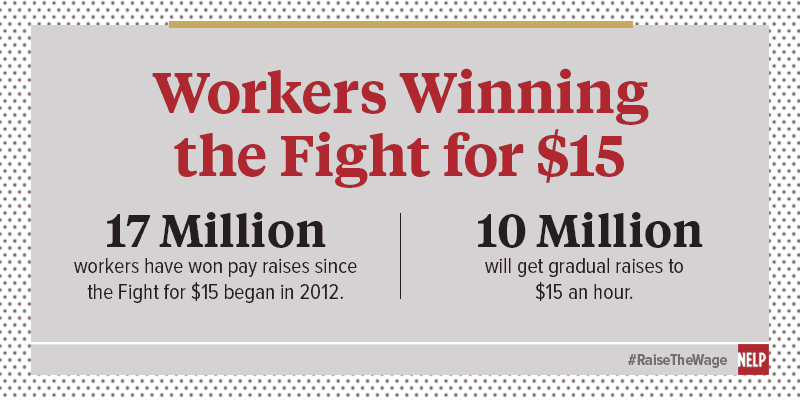Days after low-wage workers in California and New York won landmark victories for $15, tens of thousands of workers in 300 cities took to the streets on April 14th to continue pressing for a $15 minimum wage and union rights for workers across the country.
To date, an estimated 17 million workers have gotten raises since the movement began in November 2012, through a combination of new state and local laws, administrative and executive action, and voluntary action by private employers. Of those workers, 10 million will receive raises to $15 per hour.
Workers in California and New York account for close to 9 million of those who are on a path to $15.
The wave of state and local action spurred by the Fight for $15 is historic in scale. Since 2012, over 50 jurisdictions have raised their wage floors – the highest number in U.S. history. And those increases are of greater consequence than in the past. The new $15 minimum wage laws in California and New York will raise pay for more than one-third of workers in those states. In comparison, the last federal minimum wage increase to $7.25 in 2009 raised pay for just 10 percent of workers.
Support for raising wages across the country is strong among the general public and growing within the business community. Eighty percent of business executives support raising the minimum wage and understand that fighting against raises amounts to a losing battle. In New York, business groups with membership totaling more than 32,000 small businesses endorsed Gov. Cuomo’s proposal for a $15.00 minimum wage statewide.
Growing numbers of employers support minimum wage increases because they understand that strong minimum wage floors are not only good for families, but also for the broader economy. A new analysis by University of California researchers shows that, unlike small wage increases, $15 wage floors generate billions of dollars in new consumer spending, benefitting struggling working families and local economies alike. More than 75 economists have endorsed the University of California findings, and an additional 200 economists back a federal $15 wage floor.
Although the Fight for $15 is winning throughout the country, and though nearly a dozen campaigns for $15 wage floors are currently underway in various states and localities, federal action is still needed to ensure that workers in the South, Midwest and all regions of the country can meet their basic needs. Allowing the federal wage floor to continue to stagnate at $7.25 means that workers in 21 states are burdened with poverty wages.
As the movement for higher wages continues to score victories, Congress has an opportunity to ride this momentum to move legislation setting the nation’s wage floor to a robust level as proposed by Sen. Sanders and Rep. Ellison for $15, or Sen. Murray and Rep. Scott for $12. Both of these bills would also gradually phase out the subminimum tipped wage, bringing relief to millions of waiters, waitresses, nail salon workers and others trying to scrape by on tipped wages as low as $2.13 per hour.
Action at the federal level would be the ultimate victory for low-wage workers nationwide.
Related to
The Latest News
All newsMayor Bowser & D.C. Council Must Respect the Will of D.C. Voters by Rejecting Repeal of Initiative 82

Blog
New Brief Sheds Light on the Amazon’s Dangerous ‘Flex’ Labor Model

News Release
NELP Denounces Supreme Court Ruling Permitting Immediate Layoffs of Hundreds of Thousands of Federal Workers

News Release

